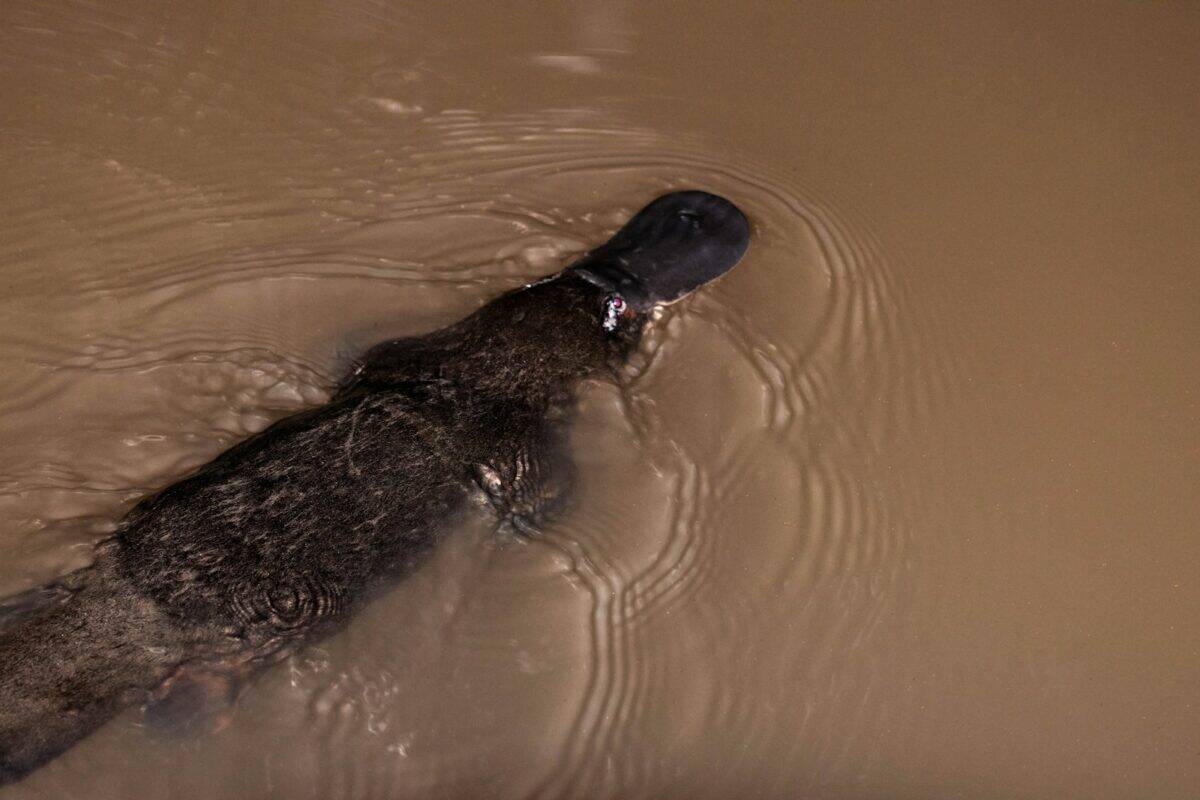The animal kingdom is filled with extraordinary sensory abilities that far surpass human capabilities. While we rely on technology to extend our sensory reach, countless species have evolved remarkable adaptations that allow them to perceive the world in ways we can barely imagine. From detecting electric fields and ultraviolet light to sensing earthquakes before they happen, these natural super senses help animals find food, avoid predators, navigate, and communicate. This exploration of 16 animals with built-in super senses reveals how evolution has equipped various creatures with astonishing perceptual abilities that help them thrive in their environments.
Star-Nosed Mole Nature’s Fastest Touch Sensor

The star-nosed mole (Condylura cristata) possesses what might be the most sensitive touch organ in the animal kingdom. Its distinctive nose features 22 fleshy appendages that form a star-like structure, containing over 100,000 nerve fibers—five times more than in the human hand, despite being much smaller. This remarkable sensory tool allows the mole to identify and consume food items in less than a quarter of a second, making it the world’s fastest mammalian forager. Living primarily underground in wet, low-visibility environments, these moles use their nasal stars to create a detailed tactile map of their surroundings, effectively “seeing” with touch. Research has shown that their brain devotes an unusually large amount of neural tissue to processing information from these touch receptors, demonstrating how evolution has optimized this species for its subterranean lifestyle.
Mantis Shrimp The Visual Virtuoso

Mantis shrimp possess what might be the most complex vision system on Earth. While humans have three types of color-receptive cones in our eyes, mantis shrimp have between 12 and 16 different photoreceptor types. This extraordinary visual system allows them to see a spectrum of light far beyond human perception, including ultraviolet, infrared, and polarized light. The mantis shrimp’s eyes sit on mobile stalks and can move independently of each other, providing enhanced depth perception and a nearly 360-degree field of vision. Perhaps most remarkably, these creatures process visual information differently than most animals—rather than comparing inputs from different photoreceptors in the brain, mantis shrimp appear to process colors at the eye level, allowing for nearly instantaneous color recognition. This visual super-sense helps them detect prey, communicate with potential mates, and navigate their complex reef environments with extraordinary precision.
Platypus Electroreception Expert

The duck-billed platypus (Ornithorhynchus anatinus), already famous for its unusual appearance and egg-laying mammal status, possesses one of the animal kingdom’s most sophisticated electroreception systems. Their distinctive bill contains thousands of specialized electroreceptors that can detect the tiny electrical fields generated by the muscle contractions of prey animals. When hunting, platypuses close their eyes, ears, and nostrils, relying entirely on electroreception to locate prey in murky waters. This sense is so refined that they can detect electrical fields as weak as 50 nanovolts per centimeter—equivalent to sensing a 1.5-volt battery connected to electrodes placed 2,000 kilometers apart. This remarkable ability evolved independently from similar systems in sharks and certain fish species, representing a case of convergent evolution. The platypus’s bill also contains mechanoreceptors for touch, creating a multi-sensory organ that allows these mammals to thrive in aquatic environments where visibility is extremely limited.
Elephants Seismic Communicators

Elephants possess an extraordinary ability to detect seismic vibrations through their feet, essentially “hearing” through the ground. Their foot pads contain specialized mechanoreceptors called Pacinian corpuscles that can detect vibrations traveling through the earth. This sensory capability allows elephants to communicate over vast distances—up to 20 miles apart—by creating low-frequency rumbles that travel both through air and ground. Research has demonstrated that elephants can distinguish between different seismic messages, potentially identifying specific family members or warnings about danger. Scientists have observed elephants placing their feet carefully on the ground and remaining still—a posture believed to optimize their seismic reception. This remarkable sense also helps them detect approaching storms and potentially even distant herds. Some research suggests elephants may have predicted the 2004 Indian Ocean tsunami, moving to higher ground before the disaster struck, showcasing how this seismic sensitivity serves as both a communication tool and a survival mechanism.
Bats Masters of Echolocation

Bats have evolved perhaps the most sophisticated biological sonar system on the planet. Most of the over 1,400 bat species use echolocation to navigate and hunt in darkness, emitting high-frequency sounds (typically 20-200 kHz, well beyond human hearing) and interpreting the returning echoes to create detailed mental maps of their surroundings. This remarkable system allows bats to detect objects as thin as a human hair in complete darkness and distinguish between different insect species based solely on their wing-beat patterns. The precision of bat echolocation is so refined that they can detect differences in surface texture and identify prey items as small as mosquitoes while flying at speeds up to 60 mph. Their brains contain specialized neural pathways dedicated to processing these echoes, allowing for rapid interpretation of complex acoustic information. Some bat species have evolved specialized nose structures, like leaf-nosed bats, that help focus their sound emissions for even greater precision. This extraordinary sensory adaptation has allowed bats to dominate the nocturnal flying niche for over 50 million years.
Sharks Living Metal Detectors

Sharks possess one of the animal kingdom’s most sensitive electroreception systems through specialized organs called ampullae of Lorenzini. These jelly-filled canals opening through pores in the shark’s snout can detect electric fields as weak as five nanovolts per centimeter—about 5 billionth of a volt. This extraordinary sensitivity allows sharks to detect the minute electrical fields generated by the muscle contractions of prey animals, even when hidden under sand or murky water where visual cues are absent. The great white shark can detect the electrical equivalent of a single D-cell battery connected to electrodes placed 1,000 miles apart in the ocean. Beyond hunting, this sensory system helps sharks navigate by detecting the Earth’s magnetic field—essentially providing them with a built-in compass. Different shark species have varying numbers and distributions of these electroreceptors, with hammerhead sharks possessing an expanded head surface area that maximizes their electroreception capabilities. This remarkable sense, combined with their acute smell, lateral line pressure detection, and specialized vision, makes sharks some of the most effectively equipped predators in marine environments.
Snakes Infrared Vision Through Specialized Pits

Certain snake species, including pit vipers, pythons, and boas, possess a remarkable adaptation that allows them to “see” heat. These snakes have specialized heat-sensitive pit organs located between their eyes and nostrils that can detect infrared radiation emitted by warm-blooded prey. The pit organs contain thousands of temperature-sensitive receptors that can detect temperature differences as small as 0.003°C and can create a thermal image that overlays with their visual perception. This sensory system is so sophisticated that pit vipers can strike with precision at warm targets in complete darkness. The neural pathways from these pit organs connect to the same brain regions that process visual information, creating an integrated thermal-visual representation of the world. This adaptation gives these snakes an extraordinary advantage when hunting mammals and birds, particularly at night when their prey’s body heat stands out sharply against cooler surroundings. Research suggests that the facial pits evolved independently in different snake lineages, representing a striking case of convergent evolution driven by the advantages of thermal detection for predators.
Catfish Taste Buds All Over Their Bodies

Catfish have evolved an extraordinary sensory adaptation that transforms their entire body into a giant taste organ. While humans have approximately 10,000 taste buds primarily located on our tongues, some catfish species possess over 175,000 taste receptors distributed across their entire body surface, with particularly high concentrations on their barbels (whiskers). This remarkable adaptation allows catfish to effectively “taste” their environment in all directions simultaneously, helping them locate food in murky waters where visibility is extremely limited. Their taste receptors are so sensitive they can detect amino acids dissolved in water at concentrations as low as one part per million. This distributed gustatory system allows catfish to follow chemical trails to food sources and avoid potentially harmful substances in their environment. The neural pathways processing this vast amount of taste information occupy a significant portion of the catfish’s brain, highlighting the evolutionary importance of this sensory system. This unique adaptation has helped make catfish one of the most successful fish families, with over 3,000 species thriving in freshwater environments across six continents.
Barn Owls Asymmetrical Hearing Specialists

Barn owls possess one of the most precise auditory systems in the animal kingdom, allowing them to hunt effectively in complete darkness. Their remarkable hearing stems from several specialized adaptations, including facial disc feathers that funnel sound to their ears and, most notably, asymmetrically positioned ear openings—one ear is typically higher than the other. This asymmetry creates minute differences in the time and intensity at which sounds reach each ear, providing the owl with precise spatial information about the sound’s origin. Experiments have shown that barn owls can locate prey by sound alone with an accuracy of less than one degree in both horizontal and vertical planes—equivalent to pinpointing the position of a mouse’s footstep from 20 feet away in total darkness. Their brain contains specialized neurons that create a neural map of auditory space, allowing for rapid and precise sound localization. Additionally, barn owls can detect frequency differences as small as 0.1%, helping them distinguish between different prey species based on their movement sounds. This extraordinary auditory specialization, combined with silent flight adaptations, makes them devastatingly effective nocturnal hunters.
Dogs Olfactory Marvels

The canine sense of smell represents one of the most impressive olfactory systems on the planet, with capabilities far exceeding human comprehension. Dogs possess up to 300 million olfactory receptors in their noses, compared to about 6 million in humans, and the part of their brain devoted to analyzing smells is proportionally 40 times larger than ours. This extraordinary sensitivity allows trained dogs to detect substances at concentrations as low as one part per trillion—equivalent to detecting a single drop of liquid in 20 Olympic-sized swimming pools. Dogs can distinguish between identical twins based on scent alone, detect certain cancers in human breath samples, and follow scent trails that are days old. Their nasal structure contributes to this ability, with a specialized fold that separates incoming air between breathing and smelling functions. Different dog breeds have varying olfactory capabilities, with scenthounds like Bloodhounds having the most acute sense of smell. This remarkable sensory adaptation explains why dogs remain irreplaceable in search and rescue, drug detection, and medical alert roles despite technological advances in artificial sensing technologies.
Electric Eels Living Batteries with Built-in Radar

Electric eels possess one of the animal kingdom’s most unique sensory-weapon combinations, using self-generated electricity both for hunting and navigation. These remarkable fish, which are actually a type of knifefish rather than true eels, can generate electric fields of up to 860 volts using specialized organs that make up 80% of their body. Beyond their famous defensive shock capability, electric eels use lower-voltage pulses as a sophisticated form of electroreception. This sensory system allows them to detect objects and prey in their murky Amazonian habitats where visibility is extremely limited. The electric eel’s body contains thousands of electroreceptors that detect distortions in their self-generated electric field when objects or animals are nearby, essentially creating a three-dimensional electrical “image” of their surroundings. Recent research has revealed that electric eels use different patterns of electrical discharge for different purposes—high-voltage pulses for hunting and defense, and lower-voltage pulses for navigation and communication. They can even use their electricity to remotely control their prey’s nervous system, causing involuntary muscle contractions that reveal hidden prey and make escape impossible. This combination of powerful electrical generation and sensitive electroreception makes electric eels one of the most uniquely adapted predators in freshwater ecosystems.
Pigeons Magnetic Compass Navigators

Pigeons possess an extraordinary navigational ability that has fascinated scientists for decades. These birds have a built-in magnetic compass that allows them to detect Earth’s magnetic field, providing them with a constant sense of direction. This remarkable adaptation involves specialized cells containing magnetite (a naturally magnetic mineral) in their beaks and inner ears, along with light-sensitive proteins called cryptochromes in their eyes that may allow them to visually “see” magnetic fields. Pigeons can navigate successfully over thousands of miles, even when released in unfamiliar locations or when visual landmarks are obscured. Research suggests they create a multi-layered navigational map using various sensory inputs, including the sun’s position, infrasound (low-frequency sounds that travel great distances), and even smell. Their magnetic sense appears particularly important for maintaining direction during long flights and on cloudy days when solar navigation is limited. Scientists have discovered that disrupting pigeons’ exposure to magnetic fields or attaching small magnets to their heads significantly impairs their navigational abilities, confirming the critical role of magnetoreception in their remarkable homing talents. This sophisticated multi-sensory navigation system explains why pigeons were historically invaluable as message carriers and continue to excel in competitive pigeon racing today.
Octopuses Taste Through Touch

Octopuses possess one of the animal kingdom’s most unusual sensory adaptations—the ability to taste what they touch. Their eight arms are covered with thousands of chemoreceptors that allow them to detect chemicals in their environment through direct contact. Unlike humans, who must bring food to their mouths to taste it, octopuses can instantaneously analyze the chemical composition of anything their arms contact. Each sucker on an octopus’s arm functions as both a grasping tool and a chemosensory organ, allowing them to “taste” potential food items without bringing them to their mouth. This distributed sensing system works in conjunction with their excellent vision to help them hunt effectively, even in complex reef environments. Research has shown that octopuses can distinguish between toxic and non-toxic prey items solely through this contact chemoreception. Their arms possess a remarkable degree of neural autonomy, with approximately two-thirds of their neurons located in their arms rather than their central brain. This decentralized nervous system allows each arm to perform complex chemical analysis independently, essentially giving octopuses eight semi-autonomous appendages that simultaneously explore and taste their surroundings. This extraordinary sensory adaptation, combined with their problem-solving intelligence, helps explain why octopuses are such successful predators despite lacking the protective shells of their mollusk relatives.
Jewel Beetles Infrared Fire Detectors

Jewel beetles of the genus Melanophila possess one of the most unusual sensory adaptations in the insect world—the ability to detect infrared radiation from forest fires. These beetles have specialized infrared receptors located in pit organs on their thorax that can detect heat from fires up to 80 miles away. This remarkable adaptation serves a critical reproductive purpose, as these beetles lay their eggs in freshly burned trees where their larvae can develop without competition from other wood-boring insects. The infrared organs contain mechanoreceptors that detect the minute expansion of fluid when heated by infrared radiation, essentially functioning as biological bolometers. Research has shown these organs are sensitive enough to detect temperature changes as small as 0.1°C. This fire-seeking behavior has evolved over millions of years, as forest fires represent natural disturbances that create ecological opportunities. Scientists studying these biological infrared detectors have used them as inspiration for developing new types of infrared sensors for applications ranging from fire detection to military technology. This remarkable sensory adaptation demonstrates how evolution can produce highly specialized sensory capabilities to exploit specific ecological niches, even those as seemingly hostile as forest fires.
Conclusion:

The animal kingdom reveals a stunning diversity of sensory adaptations that challenge the limits of human perception. From the seismic listening of elephants and the echolocation of bats to the infrared vision of snakes and the magnetic compass of pigeons, these super senses offer a glimpse into alternate realities shaped by evolutionary pressures. Each adaptation, whether it’s the star-nosed mole’s ultra-sensitive touch or the mantis shrimp’s kaleidoscopic vision, serves a vital role in the survival and success of these species. They remind us that human senses represent just one narrow way of experiencing the world—and that nature has crafted countless other ways to see, hear, feel, and navigate reality. These creatures not only expand our understanding of biology but also inspire innovation in science and technology, offering blueprints for everything from sonar to infrared sensors. Ultimately, exploring these remarkable sensory feats deepens our appreciation for the complexity and ingenuity of life on Earth.
- 12 Deep-Sea Animals That Glow in the Dark - August 15, 2025
- 14 Times Wild Animals Shocked Scientists - August 15, 2025
- 15 Animals and Wildlife that Start with Q - August 15, 2025

